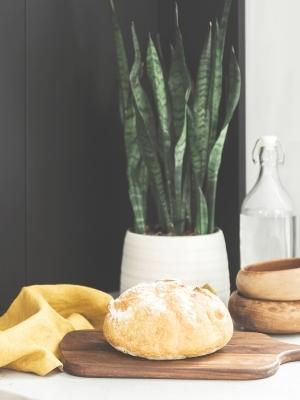How to Break a Pasta and Bread Habit
Carbs.
Who doesn’t love a piece of fresh-baked crusty bread that’s perfectly chewy on the inside and has those really big holes.
Or the creamy penne ala vodka, buttery shrimp scampi, and comforting homemade mac n’ cheese.
There are quite a few reasons why we crave these foods, have trouble resisting them, and hardly ever tire of eating them.
From the quick energy, the effect on our hormones, and even the association with fond and comforting memories eating these foods as children, it’s no wonder we develop a habit of eating them more frequently than we’d like.
Pasta and bread are not “bad” per se, however they are relatively high in calories and provide little nutritional value. They also oftentimes give you that “quick hit” of energy that declines just as rapidly, potentially leaving you feeling even more tired.
For some, pasta and bread can even lead to uncomfortable stomach bloating and joint pain, from a sensitivity to the gluten (the protein found in wheat).
Whatever your reason, it’s your reason and that’s good enough of one.
My Own Pasta and Bread “Addiction”
I love pasta and bread just like you probably do.
In fact, I like it so much so, that I was actually eating it for most meals (and not much else) through my twenties.
Pasta was my favorite food that my mom would make with dinner, so I would associate it with dinner with my Mom, Dad, and brother, Jake, as a kid.
I always had a sandwich for lunch as a kid, so it became a habit to continue that tradition.
- Related: 5 Quick and Healthy Work Lunches for the Week
- GET WEEKLY TIPS: Eating Habit and Weight Loss Tips
I was also always eating a “carb-y” breakfast, such as Cheerios, or Captain Crunch, and I usually had pretzels as an afternoon snack and cookies for my snack at night.
(I was a really active kid, so I burned all those calories quickly!)
So, as you can see, it became a habit for me to eat carbs, and as I got older, I stopped the cookie habit, but continued with the rest.
I got tired of feeling bloated though, and always seemed to be low on energy. I was working so many hours that I wanted to be able to enjoy my time off by having more energy, so I decided it was worth putting in some work to make a change.

The Initial Steps to Breaking a Pasta and Bread Habit
At the time I decided to break my pasta and bread habit, I was not yet a Certified Habit Coach, so I was doing it all without any instruction or expert “know-how”.
Determine Your Goal
I figured that the first step would be to get clear on my goal. In other words, determine ahead of time what my intention was.
I didn’t want to eliminate carbs, I mainly wanted to replace some of them with more nutrient-dense food.
So, if you’re thinking of breaking any eating habit, it’s really important to determine what your goal or intention is. Goals provide direction, motivation and also a guide for measurement.
- Related: Mistakes to Avoid With Health Goals
You have to determine where you are currently with your habit, and where you want to be. Try to be as specific as possible.
When I decided to break my pasta and bread habit, my goal wasn’t to quit eating them completely, but really to stop the habit. I didn’t want carbs to be my go-to for breakfast, mid-morning snack, lunch, afternoon snack, dinner, and dessert.
(Yes, I was eating that many carbs.)
I decided to reserve them for breakfast, lunch, dinner, and just one snack to start with. I did not have a time frame nor a structured plan to make it easier for myself, however, because I didn’t know then what I know now.
Set a Time Frame
I highly recommend putting a time frame on your goal. It provides motivation and helps with the measurement of your progress.
Just be aware that even if you don’t meet the goal in that time frame, that doesn’t mean anything about YOU. That just means that habit is going to take a little longer to break than expected.
The time frame is really just somewhat of a guess or arbitrary number. When you think of it like that, you’ll likely feel less negative emotion toward yourself if you don’t complete your goal within that time frame.
So just pick something, anything. You can always re-assess and change it in the future if needed.
The Behavior Changes That Have to Be Made
I knew that the first thing I had to do to break my pasta and bread habit was decrease the availability of carbs. That meant, making sure there weren’t as many in my house, and making sure I had more nutritious foods to choose from instead.
You don’t want to rely on willpower, so you need all the help you can get, and setting your environment up for success is key.
Although that alone won’t guarantee you’ll change your behavior, it helps to encourage you to do the behavior you’re trying to do (or avoid the one you’re trying to avoid).
The Grocery Store
Grocery shopping will look a little different for you going forward.
It will look like avoiding certain aisles or sections to decrease or eliminate purchasing whatever food it is you’re trying to avoid.
It’ll also mean exploring the produce, dairy, meat, bean and nuts sections for healthier snack and dinner options.
Once you do this every time you grocery shop, you will start to make a habit of walking to the sections with the nutritious options and avoiding the aisles with the processed carbs.
Food at Home
You’ll also need to restructure some of the food locations at home. Once you bring home the more nutritious foods from the grocery store, you’re going to want to make them easy to eat.
That means, cutting up the fruit and vegetables that you plan on eating as snacks and putting them in containers at eye level in a very visible spot in your refrigerator.
- Related: 15 Healthy Snacking Habits to Start Right Now
- GET WEEKLY TIPS: Eating Habit and Weight Loss Tips
Cutting them up ahead of time makes it much easier to just grab when you’re feeling like a snack.
Putting that ease into the behavior you’re trying to encourage goes a long way.
You’ll also want to put the foods you’re trying to avoid in harder to see and harder to reach areas. Get creative!
Start Out Slow
Any new behavior is just that, new. Which means your brain needs to get used to it.
Just as you wouldn’t start out with a 10 mile training run for a marathon if it’s been 5 years since you even ran a mile, you wouldn’t start out making ALL the changes at once.
Start out slow and ease your brain into it, so it’s less likely to resist the changes.
If I had gone from carbs at every meal to carbs just at breakfast, my brain would have said, “no way, enough of this.”
My brain LOVED carbs, so to take them almost completely away right away would have caused a lot of resistance. Meaning, I’d have to start relying on a lot of willpower to free myself of that pasta and bread habit.
That’s what you don’t want, because you know as well as I, that willpower isn’t always reliable and when it’s not, we somehow blame ourselves for “not having enough control.”
And this simply isn’t true.
Reward Yourself Along the Way
As a career woman, you’re probably used to just doing, and not celebrating. You may even be in the habit of that, so that when you do something really challenging, you fail to celebrate.
The reason why this is a problem, is that when you fail to get any reward, even if just an internal “pat on the back” or mental celebration, you are less likely to be successful with habit change in the early stages.
Wendy Woods, Professor of Psychology and Business at the University of Southern California, discusses this in her book, “Good Habits, Bad Habits.”
In it, she states “Rewards are important when you first do something. We engage executive control and form intentions about what to do in order to snag that reward.”
She also discusses some research that has revealed that after awhile though, “Habits are a kind of action that is relatively insensitive to rewards.”
What this means is, rewards play a important role in performing a behavior and performing it multiple times. However, once that behavior is performed enough times to become a habit, the reward has much less effect.
Also, celebrating successes, even the small ones, helps to drive motivation due to increasing dopamine levels. Dopamine is known as the “reward” hormone, and has been linked to motivation.
So be sure to reward yourself with something that aligns with your goals of breaking your pasta or bread habit, even if it’s just a mental celebration.
Also, do it often.
This can help to increase the motivation to keep doing the desired behavior (or avoiding the behavior you wish to avoid).
Keep Practicing
A crucial component to any habit change is repetition.
You much keep practicing the behavior change in order for a new habit to form or a habit to break.
The more frequently you do the behavior change, the better. You’ll reach habit status more quickly, and who doesn’t like the sound of that?
So, with your pasta and bread habit, you’ll have to keep practicing the new behavior of NOT eating the pasta or bread with every meal or snack.
For me, I had to keep practicing the new behavior of eating a more nutrient-dense food in place of some of my carb-heavy snacks, and eventually then in place of the bread I’d eat at lunch and the pasta I’d eat with dinner.
Final Notes
To recap, to break a pasta and bread habit, or any habit, you need a goal or intention, a timeframe for that goal, contextual cues (setting up your environment for success, reward, and repetition.
Sounds easy enough, right?
Yes and no. Oftentimes, challenges come up, especially for career women. You may have an easy time breaking a bad eating habit, or you might struggle.
If you’re struggling, I can help.

KATE JOHNSTON
Eating Habits & Weight Loss Coach
Helping career women break free from emotional eating, overeating and mindless eating.
Start feeling more healthy, confident and free by clicking the button below.
